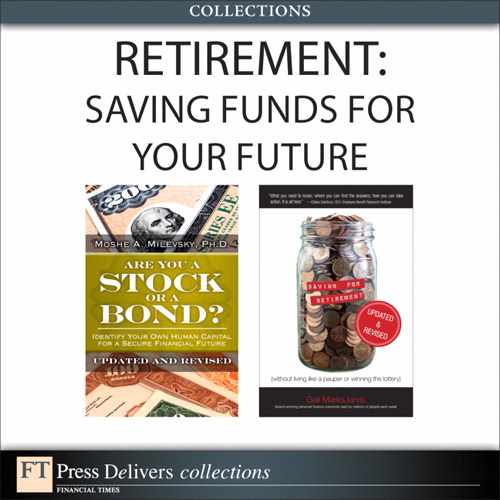Contents
Preface to the Second (Revised) Edition
Introduction: Pensions Are Dying; Long Live Pensions
Chapter 2 Insurance Is a Hedge for Human Capital
How Much Does Life Insurance Cost?
How Much Life Insurance Do I Need?
Can We Put a Value on What a Life Is Worth?
Types of Life Insurance Policies
Chapter 3 Diversification over Space and Time
Why Does Diversification Work?
Decomposing Risk: Systematic Versus Non-Systematic Risk
The Importance of International Investing
Correlations: The Magic Behind Asset Allocation
How Does Time Impact Financial Risk and Volatility?
Should I Take More Risk When I’m Younger?
Diversification and the Financial Crisis
Chapter 4 Can Debt Be Good at All Ages?
The Good, the Bad, and the Ugly of Leverage
Chapter 5 Personal Inflation and the Retirement Cost of Living
Back to Basics: Inflation’s Impact
Chapter 6 Sequence of Investment Returns
Retirement Income Trigonometry
Chapter 7 Longevity Is a Blessing and a Risk
Life Expectancy Is Not That Meaningful
Do People Understand the Odds?
Chapter 8 Spending Your Retirement in a Risky World
Chapter 9 Annuities Are Personal Pensions
Times and Products Are Changing
Back to My Research on Variable Annuities
Chapter 10 Product Allocation Is the New Asset Allocation
Introduction to Product Allocation
Guarantees Make People Feel More Comfortable
Chapter 11 Conclusion: Plan for Managing Your Retirement Risk
Retirement Income Planning Is the Goal
Last Words: Developing and Protecting Your Personal Balance Sheet
Appendix Additional References and Notes
Saving for Retirement (Without Living Like a Pauper or Winning the Lottery)
1 Start Investing Early or Start Now
The Retirement Difference: Pensions
Today’s Responsibilities Are Yours
How Financial Planners Evaluate Your Needs
Doing a Retirement Calculation Like a Pro
Imagine Your Life at 65 and 75
Women Live Longer, Need More Money
How Much Security Is Social Security?
Olden Days with Old-Style Pensions
401(k), 403(b), 457, and Profit Sharing
IRAs and Other Savings Accounts
How Do You Turn $25 a Week into $1 Million?
Using Your Calculation: The Advanced Lesson
3 Savings on Steroids: Use a 401(k) and an IRA
The Power of Warding Off Taxes
How to Use Your 401(k) or 403(b)
More Tax Help Than You Imagined
Procrastination—Not Money—Hurts
4 An IRA: Every American’s Treasure Trove
More on the Magical Power of Compounding
5 IRA Decisions: How to Start and Where to Go
Can’t I Wait Until I File My Taxes?
The Choice Between a Traditional IRA and a Roth IRA
The Traditional Tax-Deductible IRA
The Choice Between a 401(k) and a Roth IRA
Pushing IRAs and 401(k)s to the Limit
Can You Get a Tax Deduction from a Traditional IRA?
Is Your Income Too High for a Roth IRA?
Last-Minute Regrets: I Want My Money Back
Special Help for Low-Income People
What Comes First: College or Retirement Saving?
If You Operate a Small Business
Individual 401(k) or Solo 401(k)
SEP-IRA Simplified Employee Pension Plan
Simple IRA (Savings Incentive Match Plan for Employees)
6 Why the Stock Market Isn’t a Roulette Wheel
The 1990s: From Stock Lovefest to Disaster
What to Expect from the Stock Market
Stocks Provide Risks and Rewards
Novices Choosing Stocks Are Gamblers
Your Fund Is Designed for a Purpose
What Happens in a Mutual Fund?
High Stock Prices Can Be Warning Signs
8 Making Sense of Wacky Mutual Fund Names
The Three Main Choices: Stocks, Bonds, and Cash
The Trade-Off Between Seeking Safety and Making Money
9 Know Your Mutual Fund Manager’s Job
Stocks Come in Three Sizes: Know Your Size
Using the Remainder of This Chapter
Recognizing the Tortoise and the Hare: Growth Versus Value
Check Value and Growth Funds for Worst-Case Scenarios
International Stock (Equity) Funds
REITs (Real Estate Investment Trusts)
10 The Only Way That Works: Asset Allocation
The One Proven Way to Success: Asset Allocation
Start the Sorting—It’s Asset Allocation Time
The Logic Behind “Diversification”
Asset Allocation Is Simply Matching
You Don’t Need to Use Every 401(k) Fund
What’s Your Age: 20, 30, 40, 50, or 60?
A Reality Check for Fear: The Losses of the 2007–2009 Crash
12 How to Pick Mutual Funds: Bargain Shop
Tiny Percents Have a Huge Impact
Mind Your Money: Your Broker Might Not
13 Index Funds: Get What You Pay For
What’s the Stock Market, and What’s a Stock Market Index?
Tweak Your Portfolio Once a Year: Rebalance
Indexes Come in Many Varieties: An Advanced Lesson
Some Exchange-Traded Fund (ETF) Ideas
Tinkering with ETFs: For Advance Investors
Beginning Investors: Starting an IRA with Pocket Change
Warning: Not All Index Funds Are Good
14 Simple Does It: No-Brainer Investing with Target-Date Funds
What to Do When 401(k) Funds Lack Target-Date Funds
How to Select a Target-Date Fund
15 Do You Need a Financial Adviser?
Does the Financial Adviser Focus on People Like You?
